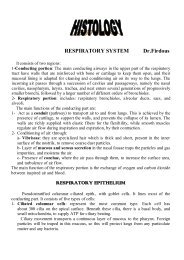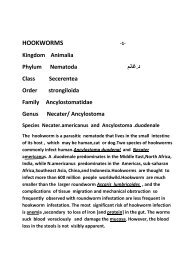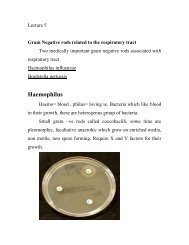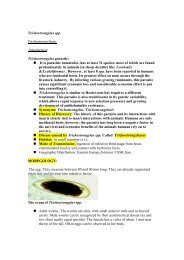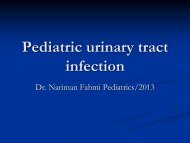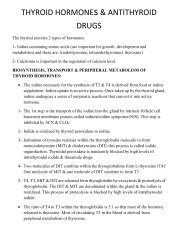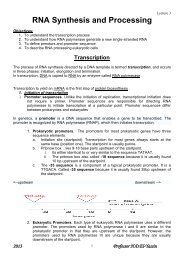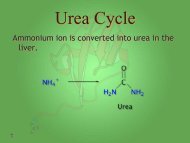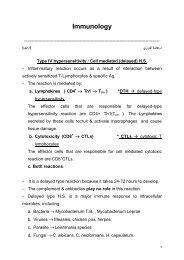Introduction to Helminths
Introduction to Helminths
Introduction to Helminths
You also want an ePaper? Increase the reach of your titles
YUMPU automatically turns print PDFs into web optimized ePapers that Google loves.
Parasi<strong>to</strong>logyهيفاء د.<strong>Introduction</strong> <strong>to</strong> <strong>Helminths</strong> (Metazoa)The term helminth has been derived from a Greek wordmeaning worn. It was originally meant <strong>to</strong> refer <strong>to</strong> only intestinalworms, but now includes tissue parasites as well as many freeliving species. These are metazoa.Classification of helminthsThe metazoa are classified in<strong>to</strong> two phyla: Platyhelminthes andNemathelminthes. Platyhelminthesis divided in<strong>to</strong> two classes:Ces<strong>to</strong>dea (tapeworms) and Trema<strong>to</strong>dea (flukes) whileNemathelminthes has only one class Nema<strong>to</strong>dea (roundworms).
Kingdom: MetazoaPhylum: Platyhelminthesa-body flattened dorsovetrally.b-body cavity absent.c-alimentary canal absent orrudimentary.d-suckers preset.e-mostly hermaphrodite.Phylum: Nemathelminthesa-body cylindrical.b-body cavity is present.c-alimentary canal complete.d-suckers absent.e-sexually differentiated.Class: Ces<strong>to</strong>deaBody: a-tapelike, segmented.Sex: b-hermaphrodite.Head: c-often with hooks andsuckers.Alimentary canal: d-absent.Body cavity: e-absentClass: Trema<strong>to</strong>deaa-leaf-like, unsegmented.b-hermaphrodite (except,Schis<strong>to</strong>soma).c-without hooks but withsuckers.d-incomplete, without anus.e-absent.Class: Nema<strong>to</strong>deaa-cylindrical, unsegmented.b-differentiated in<strong>to</strong> male andfemale worms.c-no hooks or suckers,welldeveloped buccal capsule.d-complete with anus.e-present.
General characteristics of helminths1. They do not possess organs of locomotion, so locomotionis by muscular contraction & relaxation.2. The outer covering, known as cuticle or integument. It issituated on its outer surface & may be armed with spinesor hooks. It is resistant <strong>to</strong> intestinal digestion.3. Nervous system and excre<strong>to</strong>ry system are primitive.4. Digestive system is complete, partially lost (rudimentary)or absent. The alimentary tract has entirely disappearedfrom all stages of the tapeworms (ces<strong>to</strong>des); it is greatly ornearly absent in many of the trema<strong>to</strong>des, but its presentand complete in most nema<strong>to</strong>des. The digestive system ispartially lost (rudimentary) or absent in certain parasitichelminths because of their location in the hosts (intestineor tissue), where predigested nutrient are abundant.5. Reproductive system is very well developed.6. They may be monocious or diecious. Both self-fertilizationand cross-fertilization may take place.7. Reproduction <strong>to</strong> increase the parasite population within thesame host (internal au<strong>to</strong>infection) does not occur amongcertain helminths; more over under usual conditions ofhost & environment, the number of worms that reachmaturity in any given host is limited levels that are<strong>to</strong>lerable <strong>to</strong> both host & parasite. Thus most of the peoplewho are infected with helminths are asymp<strong>to</strong>matic
carriers, & the diseased individuals among the infectedgroup are those with the heaviest worm burdens.- The terms, light moderate, and heavy as applied <strong>to</strong>worm burdens are relative and differ for the variousspecies of helminths & in people of different ages &physical status.8. When worms are crowded the collective egg output isgreat, but the output per worm is relatively low, dependingon the degree of crowding.9. The fac<strong>to</strong>rs that determine helminth population, are thoseassociated with the host-parasite relationship (i.e. theimmune fac<strong>to</strong>rs derived from the host responses & thecomplex role of co-existing infection).- Massive infection depends initially on massiveinoculation of infective larvae & eggs.10. The co-existence of several species of helminths in thesame individual (poly-helminthism) is widely prevalent.11. In some helminths, the life cycle is direct & relativelysimple; involving only one host species and a brief periodof development of an infective stage, an example is the pinworm (Enterobius vermicularis).- In a group referred <strong>to</strong> as soil transmitted helminths, thelife cycle involves only one host (man) but the infectivestage (larvae) remaining in the egg, as in Ascarislumbricords & Trichuris trichiura; or free in soil as in
hookworm species which requires a period ofdevelopment in soil, i.e. the soil functions as anintermediate host.- In other, the man-<strong>to</strong>-man cycle involves essentialdevelopment in one intermediate host as in the filarialworms & most tapeworms, or two intermediate hosts, asin most trema<strong>to</strong>des; the first being a snail or othermollusk, the 2 nd is an animal or plant that is eaten bypeople.- Intermediate hosts provide the parasite with sustenancefor essential development, protection & availability <strong>to</strong>its final host.12. Worms & larvae that migrate through or reside in tissuegenerally produce eosinophilia, focally in tissue, in theblood or in both.- Persistant hyper-eosinophilia is the most recognizedgeneral sign of helminthic infection.- Helminthic infections frequently are occult or crypticbecause certain helminths of animal develop in man, butdo not produce eggs or larvae & therefore the infectionare not patent. Such infections are referred <strong>to</strong> as nonpatent.- In addition <strong>to</strong> eosinophilia, common signals <strong>to</strong> occulthelminthic infections, somewhat in order of theirsignificance or frequency, are hepa<strong>to</strong>megaly,
pneumonitis, bronchial asthma, urticaria, subcutaneouscyst or swelling, neurologic disturbance, and deviationsin behavior.Adult worm of ces<strong>to</strong>de (tapeworm)



